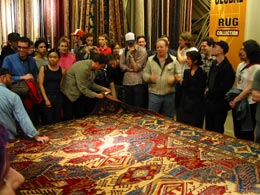Flash Mob History
2003: NYC and "Bill"
In the summer of 2003, e-mails from themobproject@yahoo.com began to circulate inviting people to convene in a public place to take part in a random act with the sole purpose of confusing others. The first successful mob took place in a New York Macy’s. There, hundreds of mobbers entered the store in search of a “love rug.” After that, about 200 people flooded the lobby and mezzanine of the Hyatt Hotel in synchronized applause for about fifteen seconds, and next a shoe boutique in SoHo was invaded by participants pretending to be tourists on a bus trip.
The idea of these mobs (and influence to future mobs) came from a man known only as “Bill.” In 2006, the identity of “Bill” was revealed to be Harper’s Magazine editor Bill Wasik. According to an interview with stayfreemagazine.org, his goal was to create an internet meme where people would simply be invited to do nothing to become part of the next big thing.
[Via Wikipedia, stayfreemagazine.org]
Subsequent media explosion
After the first New York flash mobs, USA Today, Newsweek, CNN, and Wired Magazine covered the new phenomenon. These articles explained their organization by the mysterious “Bill” through the use of e-mail listservs. These articles emphasize the random fun mobbers were having as well as the role technology and the Internet played into their success.
Soon, the New York Times ran their take on the flash mob craze: the backlash. This article told the stories of people using the Internet to spread anti-flash-mob sentiments, the lack of a point and even the decline of interest of mobbers themselves.
See the Media section for links to these and more articles from local and national newspapers and magazines.
[top]
Mobs spread around the world
Since the New York flash mobs, flash mobs began to appear in other large cities in the United States and around the world. Poland and the United Kingdom have active flash mob groups that continue the idea for mobbing for the sake of mobbing. In 2004, a flash mob in Shanghai used text messages to mobilize thousands to the streets to protest Japanese refusal to acknowledge alleged wrongs done to China by Japan during WWII.
End of NYC mobs
According the Wasik’s stayfreemagazine.org interview, the final New York flash mob came after the New York Times ran a backlash story about the flash mob movement. Wasik decided to end the mobs at the height of their popularity rather than letting them die in popularity so much so they wouldn’t attract participants.
Mobs today
Flash mobs are still popular in certain cities and college campuses. The idea of random fun or sudden protest still appeals to both young and old. Advancements in communication technology like text messages and social networking sites like MySpace and Facebook have helped people easily organize flash mobs.
Mobs today do not receive the same media attention as the first mobs of 2003, but some local media outlets continue to cover flash mobs in their area.[top]
Mobs tomorrow
Flash mobs will continue as long as people are amused by taking part in random acts of silliness. While the media exposure may continue to decline, the mobs themselves will live on through videos posted on Web sites such as YouTube, which currently has hundreds of flash mob videos available for viewing.

 Macy's mob in 2003.
Macy's mob in 2003.